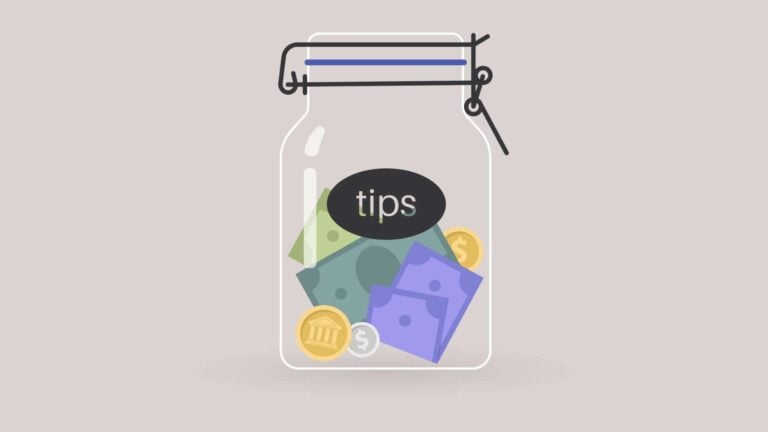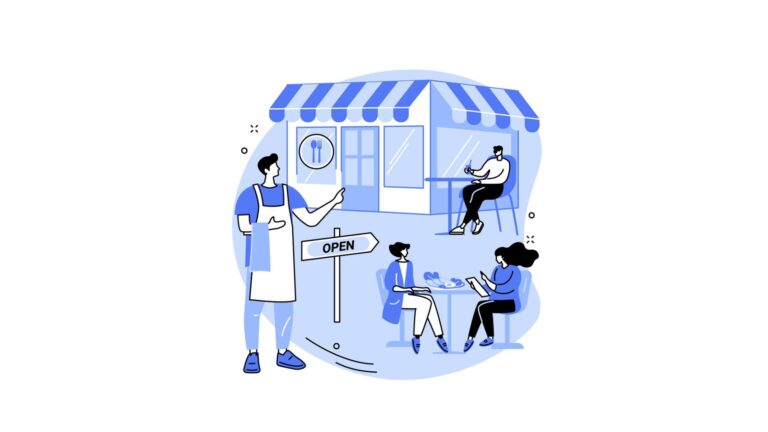Tipping in restaurants can often lead to confusion and dissatisfaction among staff if not handled correctly, which can impact workplace harmony. This guide will walk you through creating a fair tip-out structure. It addresses service expectations and legal compliance and provides tips for successful implementation.
Tipping is one of the most controversial topics in the restaurant industry. Some say it’s a reward for stellar service, while others argue it’s a confusing tradition. As a restaurateur, you’re in the middle of this controversy—juggling customer satisfaction, staff happiness, labor laws, and your profits simultaneously.
An unfair tip-out structure can lead to staff resentment. What’s worse, unhappy workers can negatively impact the overall atmosphere and efficiency of your restaurant, which can ruin your customers’ experience. But ensuring everyone gets a fair share of the tips without getting yourself into legal trouble can feel daunting.
The solution is creating a fair and transparent tip-out structure that aligns the interests of staff and management, reduces turnover, and enhances the customer experience. In this article, I’ll guide you through the essentials of creating a tip-out structure that balances fairness with functionality.
Key Takeaways
- A fair tip-out structure is essential for maintaining staff morale. It rewards all contributing employees for their services.
- When creating a tip-out system, consider your service style, labor laws, and staff roles. In addition, ensure your policy is simple and adaptable.
- Familiarize yourself with common tipping structures, including tipping pools and individual tip-outs. Select one that aligns with your restaurant’s operational flow and team dynamic.
- Successfully implement your tip-out structure by educating your staff and clearly informing your customers, promoting transparency and trust in your restaurant’s tipping policy.
What Is a Tip-Out Structure?
A tip-out structure is a system you use in your restaurant to distribute tips among your staff. It’s a set of rules that determine how your staff members share customers’ tips. This includes front-of-house staff, like servers and bartenders, and sometimes back-of-house staff, like cooks and dishwashers.
The goal is to compensate all employees who contribute to the dining experience fairly—not just the ones who directly interact with customers. Think of it as your game plan for making sure you split tips in a way that’s fair and understandable for everyone on the team.
Difference between tip-splitting, tip sharing, and tip-out
Tip splitting
This method involves servers dividing their tips equally among each other. It doesn’t account for individual performance or hours worked but treats all contributors equally.
For instance, 2 servers who collect a tip total of $200 will each take home $100, regardless of how much each individual contributed to the service.
Tip sharing
Tip sharing is a more inclusive system where a restaurant pools all tips and then redistributes them among a larger group of staff—potentially including front-of-house and back-of-house employees. The distribution usually reflects the different roles’ contributions to the service.
For example, each night, a restaurant might distribute its total tips by giving 60% to the serving staff, 20% to the kitchen staff, and 20% to the support staff.
Tip-out
This practice usually involves servers giving a portion of their tips or sales to other employees who support them, like bussers, bartenders, and food runners.
Unlike a tip split, tip-out isn’t an even split. Usually, it’s a predetermined percentage or amount based on sales or tips received.
For example, a server may tip out 5% of their sales to the bussers, or a bartender may tip out $10 to the barback.
This Might Interest You
Want to learn about the different operations of a restaurant and how to manage them efficiently? Read our in-depth guide on restaurant operations management.
Things To Consider When Creating a Tip-Out Structure
So, how do restaurants split tips? It depends on the following factors:
Type and level of service
The service style and team dynamics in your restaurant dictate your tip-out strategy. Fine dining, casual dining, fast casual, quick service, or other types of service may have different expectations and norms for tipping and tip-outs. For example:
- Fine dining restaurants may have more staff involved in serving a table—such as servers, bussers, food runners, and hosts. They might set aside a higher percentage from each tip received than other restaurants to ensure fair compensation among the staff serving each table.
- More-relaxed casual and fast casual spots, where teams usually include just servers and bussers, tips are usually divided among fewer staff members.
- For quick-service joints, customers often don’t leave tips because the service model relies on speed and self-service rather than personalized table service. As a result, a tip-out system might be unnecessary.
Compliance with labor laws
Tipping laws can be complex. You should first understand the tip regulations under the Fair Labor Standards Act (FLSA). Local tipping laws might also impact you.
Under recent FLSA regulations, it’s illegal for employers, managers, or supervisors to keep any portion of employees’ tips.
The FLSA also allows you to consider tips as part of wages for employees who customarily receive over $30 a month in tips. This is known as a “tip credit.” You must still pay a direct cash wage—the federal minimum is $2.13 per hour for tipped employees. The wage total (tip credit + cash wages) must reach at least the general federal minimum wage of $7.25 per hour.
You must clearly explain the tip credit to your employees, ensure they retain all their tips except for valid sharing arrangements, and cover any gaps if their combined cash wage and tips fall short of the minimum wage. When your state law differs from the FLSA, you must comply with the law that protects your employees the most.
For example, some states may have a higher minimum wage for tipped employees than the federal minimum wage, which may affect how much you can pay your staff and how much you can deduct from their tips.
In Delaware, restaurants pay servers a tipped minimum wage of $2.23 per hour, but the regular minimum wage is $11.75 per hour. Now, let’s say a server worked for an 8-hour day. They must earn at least $94 in total ($11.75 x 8 hours). When their tips add up to only $60, the employer must cover the $34 shortfall to meet the minimum wage requirement.
Tip-pooling laws are also complicated, and these cover tip splitting, tip sharing, and tip-outs. FLSA regulations allow for pooling tips, but they set strict guidelines on who you can include in tip pools.
Typically, when the employer takes a tip credit, only those who customarily and regularly receive tips—like servers, bartenders, and bussers—can be part of the pool. If you don’t take a tip credit, the tip pool may include other employees (like cooks and dishwashers). However, managers and supervisors can’t be part of the tip pool—regardless of whether you take a tip credit.
Pro Tip
Some states also have rules on who can participate in tip pools or tip-outs and how much they can receive. You should consult with your local labor department or a legal advisor to ensure you comply with the laws and regulations in your area.
Timing of tip distribution
When you’re setting up a tip-out structure, you must consider how and when you’ll distribute tips. Decide whether to give out tips after each shift, daily, or with payroll, taking into account your establishment’s cash flow and accounting procedures.
Businesses dealing with credit card tips must determine whether to distribute them as soon as they’re processed or include them with payroll. Your staff might prefer immediate distribution. But remember, credit card tips take time to process.
You also need to be mindful of the legal requirements around tip distribution. For example, according to FLSA regulations, employers must distribute all tips from a tip pool to employees by the scheduled payday for the period in which employees earned them. When employers can’t determine the exact tip amounts in time for payroll, they must distribute these tips as soon as possible after the designated payday.
Local regulations might also specify a timeframe for paying out tips to your employees after they earn them. For instance, some state laws require you to distribute credit card tips by the next payroll or within a certain number of days.
Transparency with your staff is crucial. Ensure they know when and how they’ll receive their tips to avoid confusion and disputes.
Staff feedback
Your workers are the ones who earn and receive tips, so their opinions and satisfaction matter. You should communicate with your staff about the tip-out structure you plan to implement and listen to their concerns and suggestions.
You should also monitor the results and effects of the tip-out structure and adjust as needed. A tipping system that works for your staff can improve their morale, motivation, and performance while reducing turnover and conflict.
Fairness
A fair tip-out structure is crucial for maintaining a positive work environment. Consider the effort and service each role provides. Does your hostess greet guests warmly? Does your dishwasher keep the kitchen running smoothly?
Your tip-out system should reflect each role’s contribution to the customer experience. For example, when generous tips might be due to the cleanliness of the dining area, a reasonable percentage could go to the bus staff responsible for cleaning. An equitable approach will help keep staff happy, motivated, and less likely to move on to other jobs.
Customer impact
Think about your guests. Their behaviors, satisfaction, and tipping behaviors are the lifeblood of your tip-out structure. Keep tabs on tipping trends, and be prepared to adjust your approach if you notice changes.
For example, say customers start tipping more for takeout services. Consider adapting your tip-out strategy to recognize the efforts of the staff involved in these services. You could allocate a generous portion of tips from takeout orders to the kitchen staff and order takers, for instance.
Adaptability and simplicity
The only constant in the restaurant industry is change. Your tip-out structure must be both adaptable and simple. It should smoothly adjust to role shifts, changes in hours, or a pivot in service—like introducing a happy hour or ramping up takeout.
However, clarity is key. An uncomplicated system avoids payroll snags and keeps your staff clear on how they receive tips, boosting their confidence and job satisfaction. Strive for a tip-out model that’s easy to understand and flexible enough to grow with your business.
7 Common Restaurant Tip-Out Structures
Here are some common examples of how restaurants split tips:
Percentage of sales
One popular approach is to base tip-outs on a sales percentage. This means a server who racks up $1,000 in sales and has a tip-out rate of 5% will distribute $50 among the support staff. It’s straightforward and ties the tip directly to the server’s performance.
Full-service restaurants often use this system because the server’s interaction with guests can significantly impact sales—from suggesting menu items to ensuring a pleasant dining experience.
- Pros: Easy to calculate and understand, aligning tip-outs with individual server success.
- Cons: Doesn’t consider the actual tips received, which can vary. Servers may feel penalized for high sales with low tips.
Percentage of tips
Some restaurants opt for a percentage of the tips earned. A server who brings in $200 in tips during a shift and must tip out 20% will share $40 with their colleagues. This method aligns tip-outs with actual tips received.
Casual dining restaurants, where tips are more variable, often use this system.
- Pros: Fair to servers, as tip-outs are based on the actual tips they receive—not just sales.
- Cons: Can lead to lower earnings for support staff during slow business periods or times when serving customers choose not to tip.
Graduated tip-out system
A tiered system increases the tip-out percentage as sales rise, although it’s more complex. For instance, tip-outs might be 2% for sales up to $500, 4% for sales between $501 and $1,000, and so on. This approach encourages staff to upsell and compensates them more for higher sales.
This structure is ideal for high-volume restaurants or those with a wide range of server sales.
- Pros: Encourages servers to boost sales since their tip-out percentage increases with performance.
- Cons: Complex to calculate and may lead to confusion or disputes among staff.
Flat amount
Some restaurants keep it simple with a flat amount. Each server might tip out a set dollar amount per shift—say $20—to split among the support staff. This straightforward method doesn’t consider sales or tip variability.
Smaller restaurants with consistent customer volumes often use flat amounts, as predictable sales make fixed tip-outs practical and fair.
- Pros: Simple to calculate. Creates consistent support staff earnings.
- Cons: Doesn’t account for variability in server sales or tips, which can sometimes feel unfair.
Position-based tip-out
This structure divides tips based on roles. For example, bussers might get 2% of a server’s sales, while the bar gets 1%. It’s a way to acknowledge the different levels of service provided by each position.
This works well in restaurants where each role distinctly adds to the service experience.
- Pros: Acknowledges that different roles contribute in different ways.
- Cons: Can become complicated if there are many roles or if each role’s contribution is hard to measure.
Tip pooling
Restaurants may pool all tips and distribute them among staff using specific methods, like formulas or points systems.
A formula approach could allocate tips according to the number of hours worked. For instance, say a restaurant collected $1,000 in tips in a week, and employees worked a total of 200 hours. Each hour worked would represent $5 in tips. So, if an employee worked 30 hours, they’d receive $150.
On the other hand, a points system could assign values to roles based on job responsibilities. Servers might receive 5 points, cooks 3 points, and dishwashers 2 points, with tips divided accordingly at the day’s end. Say the restaurant received $1,000 in tips in a day, and the total points amounted to 50. Each point would be worth $20, meaning servers would receive $100, cooks $60, and dishwashers $40 for that day.
This system is common in casual and fine dining establishments where restaurant owners emphasize teamwork.
- Pros: Promotes a team environment and equalizes the variability of tipping.
- Cons: May demotivate individual high performers and lead to conflicts if contribution perceptions vary.
Did You Know?
The term “tip pooling” is used to describe the method of pooling tips and distributing them. But the FLSA considers all tip-out structures as tip pooling.
Hybrid systems
Many restaurants combine these systems to fit their team and business model best. They might use flat amounts for slower shifts and percentages for busier times. Or, they might vary the structure based on the day of the week or season.
This approach can work for any restaurant type—particularly those with fluctuating business patterns.
- Pros: Highly adaptable, allowing restaurants to tailor the system to their unique needs and shifts in demand.
- Cons: Can be the most complex system to manage and explain to staff, requiring clear communication and occasional adjustments.
Tips for Implementing Your Restaurant Tip-Out Structure
Communicate with staff and customers
Clearly communicating your tipping policy to staff and customers sets expectations and clarifies how tips enhance service and dining experiences.
Communicate with staff
When you’re ready to implement a new tip-out structure, the first step is talking with your team. Begin with a staff meeting to introduce and explain the new tip-out structure. Illustrate how the system will work with practical examples so they can see exactly how it’ll play out on a typical day.
Most importantly, encourage them to speak up with questions or concerns. This clears up confusion and makes employees feel involved in the process.

Pro Tip
Use a dedicated team instant messaging app to keep your staff informed, engaged, and motivated. You can clearly explain the tipping system to your team, post updates, answer questions in real-time, and ensure everyone is on the same page.
Communicate with customers
Customers appreciate transparency. Knowing that their tips reward those involved in their service can enhance their dining experience. You can achieve this with the following methods:
- Place signage that politely informs customers of your tipping policy in visible areas of the restaurant.
- Include notes on your menu as a discreet way to inform diners of your tipping practices.
- Ensure your staff is well-trained to talk about the tipping policy. They should be able to explain the policy to customers in a clear and friendly way.
- If you use a digital checkout system, include a message on the screen that suggests tip amounts or explains the distribution of service charges.
Keep it legal
Ensure your tip-out policy complies with state and federal labor laws. Consult a legal expert if necessary to avoid any legal pitfalls arising from improper tip handling.
Did You Know?
Connecteam lets you store team documents securely and helps maintain records of sales, tips, and tip-outs, ensuring you stay compliant with the record-keeping requirements of the FLSA.
Educate your staff
Take the time to train your staff on the new system. This might include simple math exercises for calculating tip-outs or role-playing scenarios to demonstrate how the system handles various sales and tips.
Did You Know?
Connecteam is a powerful employee training software that lets you train your staff about the tip-out system from their mobile devices. This ensures everyone understands how you calculate their earnings.
Get started with Connecteam for free today!
Evaluate and adjust
Once your tip-out structure is in place, monitor how it works. Are your workers content with the changes? Do they understand them? Does the system feel fair to everyone? Do you notice an uptick in team performance and customer service?
Regularly collect feedback through informal chats and structured staff surveys. Look at the data, too. Are tips going up or down? Are sales being affected?
Be open to tweaking the percentages, the distribution method, or even the roles included in the tip-out based on the feedback and the data you collect.
Did You Know?
Connecteam also works as an employee communication survey app. Create and publish surveys or polls in minutes to gather your employees’ feedback on your tip-out structure.
Address discrepancies promptly
Address issues that arise quickly—whether it’s a calculation error, employee complaints about the system, or a lack of understanding among staff. Prompt attention shows you value your employees and their earnings.
Celebrate successes
When the system works well, celebrate the success. Recognizing the team’s hard work under the new structure can reinforce positive feelings and acceptance.

Did You Know?
An employee appreciation app like Connecteam can help you celebrate successes and motivate your team through personalized badges and gift cards. Highlighting employees who excel under the tip-out structure can promote a positive team spirit.
Embrace automation for efficiency
Consider using software to track and calculate tips. Automation reduces errors and saves time, making the whole process smoother for everyone involved.
Here’s how you can streamline tip-out tasks with a restaurant management app like Connecteam:
- Automate tip calculation based on the percentage of sales, hours worked, or other custom criteria you set.
- Set up automatic distributions to divide tips according to your established structure.
- Generate automated reports that give insight into tipping trends, staff performance, and customer satisfaction.
- Stay updated with the latest tip-pooling laws and regulations, as some software can alert you to regulation changes and/or help maintain compliance.
- Automate record keeping for tax purposes and compliance.
- Connect your tipping system directly to payroll services to ensure accurate and timely compensation for your staff.
- Enable employees to access their tipping information through the app, fostering a culture of openness.
- Send updates—like changes to the tip-out policy.
This Might Interest You
Want to know more about how restaurants can automate administrative tasks and prevent payroll and compliance errors? Read our in-depth review of the 6 best restaurant HR software for 2025.
Conclusion
There’s no one-size-fits-all solution to a tip-out structure. You should first assess your business type and legal considerations. Then, implement a tip-out structure that keeps workers happy and your business flourishing.
Need help? Connecteam is the perfect next step in ensuring a smooth and fair tipping process, with features like in-app communication tools, training capabilities, transparent record-keeping, and much more.
Get started with Connecteam for free today.
FAQs
What is the difference between a tip and a gratuity?
A tip is a voluntary amount a customer gives directly to a service employee to show appreciation for good service. A gratuity, however, is a fixed charge added to a bill by the organization for large groups or special services, and it’s usually divided among the staff.
Do restaurant owners pay payroll taxes on tips?
Yes. In the US, restaurant owners must pay payroll taxes on cash tips their employees receive since the IRS treats all tips as taxable income. This means tips are subject to federal income, Social Security, and Medicare taxes.




